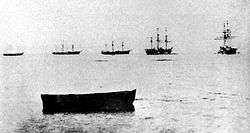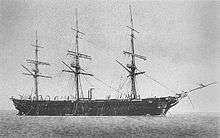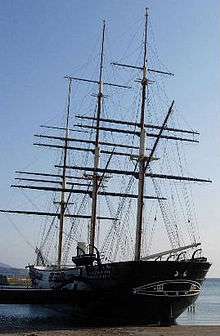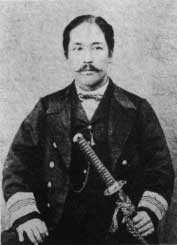Japanese frigate Kaiyō Maru
 | |
| History | |
|---|---|
| Name: | Kaiyomaru |
| Ordered: | 1863 |
| Builder: | C.Gips and Sons, Dordrecht, Netherlands |
| Laid down: | August 1863 |
| Launched: | 3 November 1865 |
| Commissioned: | 10 September 1866 |
| Decommissioned: | 1869 |
| Fate: |
|
| General characteristics | |
| Displacement: | 2,590 long tons (2,632 t) |
| Length: | 72.2 m (236 ft 11 in) o/a |
| Beam: | 13.04 m (42 ft 9 in) |
| Draught: | 6.4 m (21 ft) |
| Propulsion: | Coal-fired auxiliary steam engine, 400 hp |
| Sail plan: |
|
| Speed: | 10 knots (12 mph; 19 km/h) |
| Armament: |
|
Kaiyō Maru (開陽丸) was one of Japan's first modern warships, powered by both sails and steam.
Construction

She was ordered in the Netherlands in 1863 by the Bakufu, the government of the Shogun, the Nederlandsche Handel-Maatschappij acting as agents. The ship was built at the yard of Cornelis Gips and Sons in Dordrecht, the Netherlands for the sum of 831,200 guilders.[1] At the time of launch, she was the largest wooden warship ever built by a Dutch shipyard.[2]
The construction was overseen by a Japanese military mission under Uchida Masao and Akamatsu Noriyoshi.[3]
Transportation
She sailed on her maiden voyage to Japan under the command of capt. J.A.E. Dinaux, a Dutch naval officer, seconded for the mission. She arrived in Japan on 26 March 1867.
On board was Enomoto Takeaki, a Japanese Navy student who had been sent to study Naval science in the Netherlands for five years, together with fifteen other students.[4] Enomoto Takeaki was to become vice-admiral (副総裁) of the modernized Bakufu fleet upon his return to Japan, and Kaiyō Maru was to become his flagship.
Career

The Boshin War erupted soon after, near the end of 1867, in which pro-Imperial forces fought the Bakufu forces between 1867 and 1869. In September 1868, Enomoto Takeaki decided to continue combat in northern Japan together with the Daimyos faithful to the Bakufu regime, and sailed out of Shinagawa in Tokyo towards the north, with Kaiyō Maru and seven other modern ships. The ship was also carrying on board a handful of French military advisors, and their leader Jules Brunet. The rebels ended up in Hokkaidō, where they established an independent and ephemeral Ezo Republic.


Kaiyō Maru eventually became the main ship of the fleet in Hokkaidō. Many hopes were put in her to achieve naval superiority against a weaker and nascent Imperial Japanese Navy, but she eventually was wrecked in Esashi, Hokkaidō, during a storm on 15 November 1868.
Her demise is said to have demoralized Enomoto Takeaki, who had sailed in her from the other side of the world, and clearly reduced the chances of the rebel forces to succeed.
Salvage
The guns and ship chandlery of the Kaiyō Maru were discovered on the seafloor on August 14, 1968 by the submarine Yomiurigo.[5] Further remains were discovered but project financing prevented the salvage at that time however several items were recovered in 1969.[5] Dives were conducted in August 1974 that confirmed a need for excavation of the extensive remains. Full scale excavation of the wreck from a depth of 15 meters began in June 1975.[5]
The salvage of portions of the wreck located in the open sea were completed in seven years. The inland portions of the wreck were slowed by poor visibility. Costs for the salvage totaled over 3 million yen by 1985.[5] Desalinization of the recovered artifacts began upon recovery.
A replica of the Kaiyō Maru was constructed in 1990. She is now on display at the docks in Esashi and has become a tourist attraction showing the salvaged remains of the original ship.
Notes
- ↑ See Scheepswerf van Gips "De Merwede" Anno 1796 te Dordrecht
- ↑ Bridging the Divide Leonard Blusse, p.183
- ↑ Otterspeer, W. (1989) Leiden Oriental Connections, Brill, ISBN 90-04-09022-3, p. 367
- ↑ Seiichi Iwao, in Biographical Dictionary of Japanese History (1978), p. 325, claims that Enomoto commanded the ship. However, in the archives of the Nederlandsche Handel-Maatschappij, nrs. 4997-5003 (now in the Dutch National Archives) the correspondence about the construction of the ship and its maiden voyage, including the contracts with capt. Dinaux and his chief engineer, first mate and ship's surgeon are kept, which contradict this
- 1 2 3 4 Araki, S (1985). "Ruins on the ocean floor (Salvaging the Kaiyo Maru).". In: Mitchell, CT (ed). Diving for Science…1985. Proceedings of the Joint American Academy of Underwater Sciences and Confederation Mondiale des Activités Subaquatiques annual scientific diving symposium 31 October - 3 November 1985 La Jolla, California, USA. Retrieved 2012-04-05.
References
- Bridging the Divide Léonard Blussé, 2000, Hotei Publishing ISBN 90-74822-24-X
External links
- A replica of the Kaiyō Maru in Esashi (Japanese)
Coordinates: 41°51′57″N 140°07′02″E / 41.8658°N 140.1172°E
